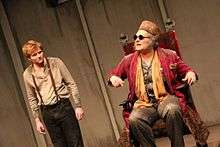Endgame (play)
| Endgame | |
|---|---|
 2016 Gustavus Adolphus College production of Endgame | |
| Written by | Samuel Beckett |
| Characters |
Hamm Clov Nagg Nell |
| Date premiered | 3 April 1957 |
| Place premiered | Royal Court Theatre, London |
| Original language | French |
| Genre | Tragicomedy |
Endgame, by Samuel Beckett, is a one-act play with four characters. It was originally written in French (entitled Fin de partie); Beckett himself translated it into English. The play was first performed in a French-language production at the Royal Court Theatre in London, opening on 3 April 1957. It is commonly considered, along with such works as Waiting for Godot, to be among Beckett's best works.
Characters
- Hamm – unable to stand and blind
- Clov – Hamm's servant; unable to sit. Taken in by Hamm as a child.
- Nagg – Hamm's father; has no legs and lives in a dustbin.
- Nell – Hamm's mother; has no legs and lives in a dustbin next to Nagg.
Production history
The play was premiered on 3 April 1957 at the Royal Court Theatre, London, directed by Roger Blin, who also played Hamm; Jean Martin was Clov, Georges Adet was Nagg and Christine Tsingos was Nell. In the early 1960s, an English language production produced by Philippe Staib and, directed by Beckett himself with Patrick Magee and Jack MacGowran was staged at the Studio des Champs-Elysees, Paris. Other early productions were those at the Cherry Lane Theatre, New York, 28 January 1958, directed by Alan Schneider with Lester Rawlins as Hamm and Alvin Epstein together with Gerald Hiken playing Clov; and at the Royal Court directed by George Devine who also played Hamm, with Jack MacGowran as Clov.[1]
After the Paris production, Beckett himself directed two other productions of the play: at the Schiller Theater Werkstatt, Berlin, 26 September 1967, with Ernst Schröder as Hamm and Horst Bollmann as Clov; and at the Riverside Studios, London, May 1980 with Rick Cluchey as Hamm and Bud Thorpe as Clov.[1]
In 1984, JoAnne Akalaitis directed the play at the American Repertory Theatre in Cambridge, Massachusetts. The production featured music from Philip Glass and was set in a derelict subway tunnel. Grove Press, the owner of Beckett's work, took legal action against the theatre. The issue was settled out of court through the agreement of an insert into the program, part of which was written by Beckett himself:
Any production of Endgame which ignores my stage directions is completely unacceptable to me. My play requires an empty room and two small windows. The American Repertory Theater production which dismisses my directions is a complete parody of the play as conceived by me. Anybody who cares for the work couldn't fail to be disgusted by this.[2]
In 2005, Tony Roberts starred as Hamm in a revival directed by Charlotte Moore at the Irish Repertory Theater in New York City with Alvin Epstein as Nagg, Adam Heller as Clov and Kathryn Grody as Nell.[3]
In 2008 there was a brief revival staged at the Brooklyn Academy of Music starring John Turturro as Hamm, Max Casella as Clov, Alvin Epstein as Nagg and Elaine Stritch as Nell. New York theatre veteran Andrei Belgrader directed, replacing originally sought Sam Mendes at the helm of the production.
The British theatre company Complicite staged the play in London's West End with Mark Rylance as Hamm and Simon McBurney (who also directed the production) as Clov. The production also featured Tom Hickey as Nagg and Miriam Margolyes as Nell.[4] The production opened on 2 October 2009 at the Duchess Theatre.[4] Tim Hatley designed the set.[4]
In 2010, Steppenwolf Theatre Company staged Endgame. It was directed by Frank Galati and starred Ian Barford as Clov, William Petersen as Hamm, Francis Guinan as Nagg, and Martha Lavey as Nell. James Schuette was responsible for set and scenic sesign.[5]
In 2015, two of Australia's major state theatre companies will stage the play. For Sydney Theatre Company, Andrew Upton will direct the production, featuring Hugo Weaving as Hamm [6] and for Melbourne Theatre Company, Colin Friels will star in a production directed by Sam Strong and designed by visual artist Callum Morton.[7]
In 2016, Coronation Street actors David Neilson and Chris Gascoyne starred in a staging of the play at both the Citizens Theatre in Glasgow and HOME in Manchester.
References
- 1 2 Gontarski, S.E. (1992), The Theatrical Notebooks of Samuel Beckett, Volume II: Endgame, London: Faber and Faber, pp. xxvii–xxviii, ISBN 0-571-14544-2
- ↑ 2009 McCarthy pp.102
- ↑ Isherwood, Charles (25 February 2005). "A Sugarplum Vision Becomes a Taunting Specter". The New York Times.
- 1 2 3 From the programme to the production.
- ↑ "Endgame | Steppenwolf Theatre". www.steppenwolf.org. Retrieved 2016-11-17.
- ↑ https://www.sydneytheatre.com.au/whats-on/productions/2015/endgame
- ↑ http://www.mtc.com.au/plays-and-tickets/mainstage-2015/endgame/
Sources
- Adorno, Theodor W. 1961. "Trying to Understand Endgame." The New German Critique 26 (Spring-Summer 1982): 119–150. Rpt. in The Adorno Reader. Ed. Brian O'Connor. London: Blackwell, 2000. 319–352. ISBN 0-631-21077-6.
- Cavell, Stanley. "Ending the Waiting Game: A Reading of Beckett's Endgame." Must we mean what we say? Cambridge: Cambridge University Press, 1969. 115–162.
- Cohn, Ruby. 1973. Back to Beckett. Princeton: Princeton UP. ISBN 0-691-06256-0.
- McCarthy, Sean. 2009. "Giving Sam a Second Life: Beckett's Plays in the Age of Convergent Media." Texas Studies in Literature and Language.